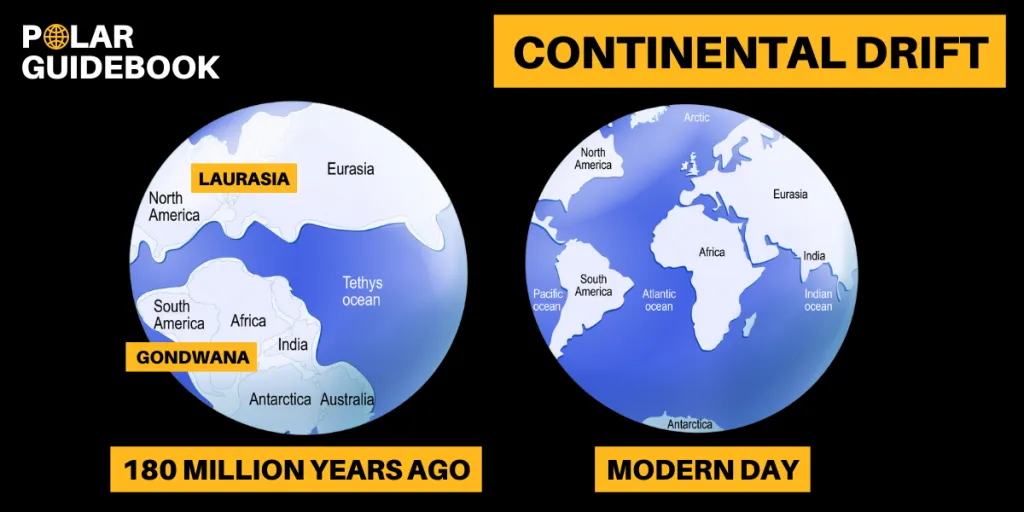It’s hard to believe Earth’s southernmost continent as anything other than the vast expanse of ice that it is today, but it hasn’t always been like this. So, how was Antarctica formed?
The Antarctica we know today was formed when it moved to its position over the south pole around 33 million years ago and decreasing CO2 in the atmosphere caused temperatures to drop, allowing thick ice sheets to form. Before this, it was a tropical rainforest roamed by dinosaurs.
In the rest of this article, we’ll take a deeper look at the history of how Antarctica was formed, why it froze over, and what it was like before.
How Was Antarctica Formed?
Antarctica was once part of the supercontinent Gondwana along with South America, Africa, Australia, New Zealand, India, and Arabia. It made up most of today’s southern hemisphere.

Gondwana began to break up in the Jurrasic period around 180 million years ago, initially, it split in half with South America and Africa breaking away from Australia, Antarctica, India, and Arabia.
Over time, these halves broke down further. But it wasn’t until 33 million years ago that Antarctica finally broke away from Australia and the two drifted apart and Antarctica took its place over the South Pole1 (source: Wet Tropics Management Authority).
It is unclear exactly when the Drake Passage opened up and whether this was before or after Antarctica separated from Australia, estimates put it anywhere between 49 and 17 million years ago2 (source: H.D. Scher and E.E. Martin, Science, Vol 312, Issue 5772, pp. 428-430, 2006). Whenever this was, it contributed to the freezing over of Antarctica as it allowed the Antarctic Circumpolar Current to take hold, more on this below.
What Was Antarctica Like Before the Ice?
Antarctica hasn’t always been covered in thick ice sheets. Before it drifted to the south pole, it was connected to Australia and had a very different climate.
Thanks to a project called Bedmap2 which has provided a detailed topological map of the landmass that sits underneath the ice, we have a very good idea of what the continent was once like.
Before the ice, Antarctica was a continent with a complex landscape of mountain ranges, hills, and rolling plains, broken up by valleys and deep gorges3 (source: British Antarctic Survey). Another fact about Antarctica is that it was home to 138 volcanoes, most of which are located in West Antarctica which is one of the densest volcanic regions on Earth4 (source: M. van Wyk de Vries, et al., Geological Society Special Publications, Vol. 461, pp.231-248, 2017).
According to Professor Jane Francis, Director of the British Antarctic Survey, Antarctica has been through many different phases. It was once very tropical with high temperatures and vegetation much like that found in the Amazon rainforest.
But with the cooling of the atmosphere, these warmth-loving plants disappeared and were replaced with cooler temperature plants around 40-50 million years ago, such as southern beech, ferns, and pollen plants, making Antarctica comparable to the forests found in modern-day New Zealand5 (source: Victoria University of Wellington – YouTube).
Were There Dinosaurs in Antarctica?
Although penguins and seals can be found breeding in Antarctica, there are no terrestrial animals native to the continent today. However, this hasn’t always been the case.
There is evidence that there were dinosaurs roaming Antarctica during the Jurrasic period, this was at a time when Antarctica was still part of the supercontinent Gondwana and it was full of tropical green rainforests. At this time, dinosaurs would have been free to wander between Antarctica, Australia, Africa, South America, India, and Arabia since these were all connected.
The first dinosaur fossils found in Antarctica were the remains of an Ankylosaurus uncovered on James Ross Island, just off the Antarctic peninsular, in 1987. Since then, remains of a Hypsilophodon, a Hadrosaurus, a Cryolophosaurus, and a Glacialisaurus are among those discovered, with the latter two being named for the first time following their discovery in Antarctica6 (source: A.J.Hund, Antarctica and the Arctic Circle, p.220).
The dinosaurs became extinct from Antarctica around 66 million years ago when a catastrophic event caused many animals on Earth to be wiped out, including dinosaurs pterosaurs, large marine reptiles, and ammonites. This was likely due to the sudden impact of an asteroid7 (source: Natural History Museum).
However, this wasn’t the end of life in Antarctica, other marine and terrestrial groups continued to exist in Antarctica such as reptiles for many millions of years after this.
But another extinction event occurred around 2 to 3 million years ago which is why there are no terrestrial animals there today. This event was less sudden than the asteroid which wiped out the dinosaurs and probably involved changing climates over many years8 (source: Australian Antarctic Program).
Did Humans Ever Live in Antarctica?
No, humans do not live in Antarctica now and never have done (except for scientists and those protecting the continent who reside there temporarily). This is because humans didn’t evolve in Africa until around 2-6 million years ago9 (source: Smithsonian Institute), long after it froze over and became uninhabitable.
How Did Ice Come to Antarctica?
The last time Antarctica was ice-free was around 34 million years ago. So, how did Antarctica go from luscious green forests to a polar desert?
Antarctica froze over as a result of several factors combined. Firstly, the landmass moving to its current position over the south pole, the lowering of overall temperatures on Earth due to decreasing CO2, and finally, the opening of the drake passage which started the Antarctic Circumpolar Current10 (source: Discovering Antarctica).
Let’s look at each of these in turn:
- Position over the south pole – Antarctica hasn’t always sat at the south pole but it drifted that way during the break up of the supercontinent Gondwana. Whilst this itself didn’t cause the ice sheets, it was a pre-requisite for the following two events.
- Lowering of temperatures on Earth – Around 34 million years ago there was a rapid decrease in CO2 on Earth with levels falling by about 40%. Over a 100,000 year period, this led to the extinction of many animals and the formation of a mile-thick ice sheet over Antarctica which had now shifted to its position over the south pole11 (source: M. Pagani, et al., Science, Vol 334, Issue 6060, pp. 1261-1264, 2011).
- Opening of the Drake Passage – The Drake Passage is the body of water between Antarctica and the tip of South America. When this opened at around the same time as the lowering of temperatures on Earth, it allowed the formation of the Antarctic Circumpolar Current (ACC) which is the world’s largest deep current. The ACC flows right around Antarctica and effectively cuts it off from warmer waters of the north and keeps it really cold12 (source: R. Livermore, et al., Science Letters 236. 459-470, 2005).
What Would Happen If the Ice in Antarctica Melted?
With climate change increasing at a rapid rate, could Antarctica return to its former sub-tropical habitat?
Well, no this is very unlikely. Even without ice, Antarctica’s current position over the south pole means that it goes for 6 months at a time without daylight (known as a polar night). This would make it difficult for anything other than lower-level plants to grow substantially.
See our full article with 5 things that would happen if the ice in Antarctica melted.
Who Decided Antarctica Was a Continent?
There was never much doubt that Antarctica was a continent. After first spotting the ice sheets in 1820, it was already being referred to as a continent in 1838 by Charles Wilkes during the United States Exploring Expedition13 (source: M.W. Lewis and K.E. Wigen, The Myth of Continents: a Critique of Metageography, 1997).
It has since been referred to as a continent in almost every model, from the 7-continent model used in English-speaking schools right down to the 4-continent model14 (source: Wikipedia).
However, it’s only in the last 50 years that we’ve been able to prove that there is land underneath and begin mapping its terrain15 (source: British Antarctic Survey).
Related Questions
Is There Land Under Antarctica?
Yes, there’s a large landmass underneath Antarctica which is why it’s known as a continent.
How Did Antarctica Get Its Name?
The word Antarctica comes from the Greek word ‘antarktikos’ which means ‘opposite of the arctic’. In turn, the word ‘arktikos’ comes from the Greek for ‘of the bear’ which references the constellation called Osa Menor, where you can find the Polar Star, which marks the North Pole16 (source: Instituto Antártico Uruguayo).
How Big is Antarctica?
Antarctica is 14.2 million km2 making it the 5th largest continent on Earth, bigger than Australia and Europe. It’s covered by two large ice sheets which are up to 1,800m thick and weigh 27 million billion tons.
Who Discovered Antarctica?
Antarctica was first discovered by westerners in 1820 when a Russian expedition led by Fabian Gottlieb von Bellingshausen and Mikhail Lazarev spotted the continent, only to be ‘discovered’ by a British expedition 3 days later.
Although these are the first confirmed sightings of the continent, oral tradition suggests that Ui-te-Rangiora from Aotearoa (modern-day New Zealand) encountered a ‘frozen region’ whilst sailing south in the vessel Te Ivi o Atea as early as 650 CE, that’s 1,100 years earlier than 182017 (source: P.W. Wehi, et al, A short scan of Māori journeys to Antarctica, Journal of the Royal Society of New Zealand, 2021).


![You are currently viewing How Was Antarctica Formed? [+ Other Questions About Its Natural History]](https://polarguidebook.com/wp-content/uploads/2022/03/How-Was-Antarctica-Formed.jpg)
![Read more about the article Are There Volcanoes in Antarctica? [Yes, And Some Are Active!]](https://polarguidebook.com/wp-content/uploads/2022/03/Are-the-volcanoes-in-Antarctica-300x150.jpg)

![Read more about the article Is Antarctica a Desert or Tundra? [Both – Here’s How]](https://polarguidebook.com/wp-content/uploads/2021/07/Antarctic-Desert-300x176.jpg)